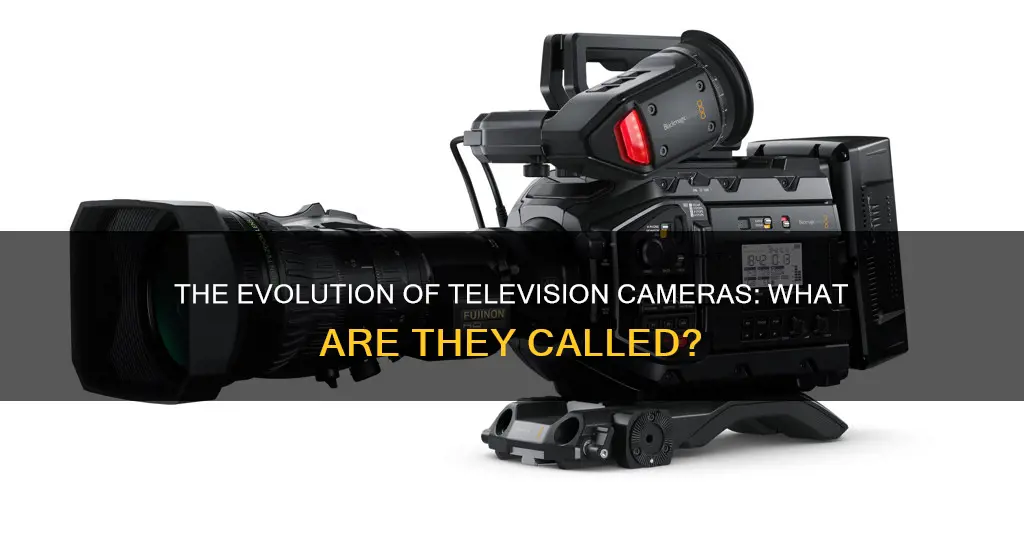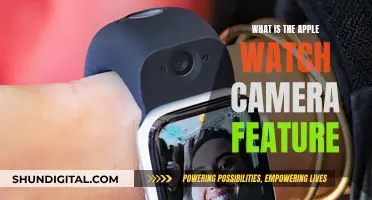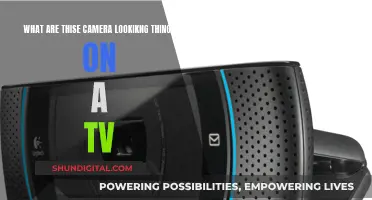
Television cameras, also known as broadcast or studio cameras, are optical instruments that convert light into an electronic signal that can be stored, transmitted, and displayed on a television receiver or monitor. They are used in television production to shoot a wide range of material, including television series, news, sporting events, and documentaries. There are two primary modes of using television cameras: live television, where the camera feeds real-time images directly to a screen, and recording images to a storage device for archiving or further processing. With the advent of digital technology, television cameras have become more advanced, offering extremely fine-grained manual control and enhanced clarity.
| Characteristics | Values |
|---|---|
| Purpose | Produce images that tell a story, inform or entertain an audience, or record an event |
| Other Names | Studio Cameras, ENG Cameras |
| Types | Wired Security Cameras, Analog Security Cameras, IP Cameras, Camcorders, CCTV, Webcams |
| Functionality | Capture and record videos, convert light into an electronic signal, zoom, focus, control aperture |
| Use Cases | Television series, studio programs, news, sporting events, music videos, motion pictures, documentaries, training sessions, security and surveillance |
| Users | Television stations, cable networks, independent production companies, private individuals |
What You'll Learn
- Television cameras are also called broadcast cameras or studio cameras
- They are used in television studios, for live events, and in the field for newsgathering
- Television cameras change light into an electronic signal that can be stored or displayed on a television receiver
- Cameras used for television have manual controls, but are becoming increasingly automated
- Camera operators need good eyesight, artistic ability, hand-eye coordination, patience, and accuracy

Television cameras are also called broadcast cameras or studio cameras
Television cameras capture light and change it into an electronic signal that can be stored, transmitted, and displayed on a television receiver or monitor. They are usually equipped with three sensors that separately record red, green, and blue. They also have three controls: the iris, focus, and zoom. The iris controls the amount of light passing through the lens, with the lowest f-stop letting in the most light and the highest letting in the least. The focus control adjusts the distance of the subject from the camera, and the zoom control changes the focal length of the lens, allowing for a wider or narrower field of view.
Broadcast cameras come in a variety of shapes and sizes, including shoulder-mounted cameras for larger lenses, and box cameras designed for tripod or wall mounting. They can be used in TV studios or for live event shooting, depending on the requirements of the production.
With the advent of digital technology, television cameras have become more advanced, offering extremely fine-grained manual control and enhanced clarity. This has resulted in a wider range of angles and improved overall quality of television footage.
Exploring Apple Watch: Accessing the Camera Functionality
You may want to see also

They are used in television studios, for live events, and in the field for newsgathering
Television cameras, also known as broadcast cameras, studio cameras, or ENG (electronic news-gathering) cameras, are optical instruments that convert light into an electronic signal that can be transmitted and displayed on television receivers or monitors. They are used in television studios, for live events, and in the field for newsgathering.
In a television studio, camera operators typically shoot from a fixed position, using either shoulder-mounted or tripod-mounted cameras. Studio cameras generally offer fine-grained manual control for the camera operator and often have three sensors to separately record red, green, and blue colours. They may also be used in conjunction with signal converters, camera batteries, lens accessories, and viewfinders.
ENG operators, on the other hand, work as part of a reporting team and are always on the move, following newsworthy events as they unfold. They must be able to anticipate the action and react quickly to capture live events. ENG operators may also need to edit raw footage on the spot for relay to a television affiliate for broadcast.
Both studio and ENG cameras come in a variety of shapes and sizes. While some have built-in lenses, others use interchangeable lenses connected via different mounts. The choice of lens and camera depends on the specific requirements of the shoot.
Accessing Yi Camera Footage on PC: A Step-by-Step Guide
You may want to see also

Television cameras change light into an electronic signal that can be stored or displayed on a television receiver
Television cameras are optical instruments that capture videos and change light into an electronic signal that can be stored or displayed on a television receiver. They are different from movie cameras, which record images on film.
The first television cameras used a specialised form of cathode ray tube called a video tube to scan the image and convert it into an electrical signal. This signal could then be broadcast and converted back into video by an image-forming cathode ray tube in the viewer's television. These early television cameras were based on the mechanical Nipkow disk and were used in experimental broadcasts through the 1910s to 1930s.
All-electronic designs based on the video camera tube, such as Vladimir Zworykin's Iconoscope and Philo Farnsworth's image dissector, replaced the Nipkow system by the 1930s. These cameras remained in wide use until the 1980s when they were supplanted by cameras based on solid-state image sensors such as the charge-coupled device (CCD).
Today, television cameras have numerous designs and uses. Professional video cameras used in television production may be television studio-based or mobile in the case of an electronic field production (EFP). Such cameras generally offer extremely fine-grained manual control for the camera operator and use three sensors to separately record red, green, and blue. Camcorders combine a camera and a recording device in one unit and are commonly used in television production, electronic news gathering (ENG), and citizen journalism. Closed-circuit television (CCTV) cameras are designed to be small, easily hidden, and able to operate unattended for security, surveillance, and monitoring purposes.
The Privacy Paradox: Cameras in Suicide Watch Cells
You may want to see also

Cameras used for television have manual controls, but are becoming increasingly automated
Cameras used for television are known as broadcast cameras, studio cameras, or ENG (electronic news-gathering) cameras. These cameras are used to shoot a wide range of material, including television series, studio programs, news and sporting events, documentaries, and more.
While television cameras have traditionally offered manual control for the camera operator, they are becoming increasingly automated. The modern television lens has three controls: iris, focus, and zoom. On a fully automatic camera, the focus and iris are automatically adjusted based on lighting conditions, but the operator can still adjust these settings manually if needed.
Professional video cameras used in television production generally provide extremely fine-grained manual control, often excluding automated operation. However, with advancements in digital technology, television cameras are increasingly incorporating automated features. For example, automatic gain control can adjust the level of the brightest parts of an image, and auto white balance can adjust the colour temperature to match the lighting conditions.
In addition to automation, digital technology has also enhanced the number of angles and the clarity that a camera operator can achieve. This technology has improved the overall quality of television images, allowing for sharper and clearer pictures.
Vizio M-Series TV: Camera Included or Not?
You may want to see also

Camera operators need good eyesight, artistic ability, hand-eye coordination, patience, and accuracy
Television cameras, also known as broadcast cameras, studio cameras, or ENG (electronic news-gathering) cameras, are used to capture images for various purposes, including news, sports, television series, and documentaries. Camera operators play a crucial role in this process, and several key attributes contribute to their success.
One of the most important requirements for camera operators is good eyesight. Sharp vision is essential for ensuring that the images captured by the camera are clear, focused, and composed effectively. Artistic ability is another vital aspect, as it enables operators to compose visually appealing shots that enhance the storytelling process. This includes understanding the impact of different camera angles, lighting, and framing on the overall aesthetic of the final image.
In addition to good eyesight and artistic ability, hand-eye coordination is crucial for camera operators. This skill ensures that operators can smoothly and accurately adjust camera settings, such as focus, iris, and zoom, to capture the desired image. It also helps them react quickly to unfolding events, ensuring they can capture the action as it happens. For example, during a live news broadcast, a camera operator with excellent hand-eye coordination can quickly adjust the camera's position and settings to capture a sudden development, ensuring the audience sees the story as it unfolds.
Patience and accuracy are also vital traits for camera operators. They often need to wait long hours for an event to occur, and once it does, they must be accurate and precise in capturing the moment. For instance, during a sporting event, a camera operator may need to patiently track the action, waiting for the perfect moment to capture a pivotal play or a record-breaking achievement. Accuracy is essential to ensure that the camera is correctly focused and framed on the subject, capturing the moment with clarity and precision.
In conclusion, camera operators in television require a unique set of skills, including good eyesight, artistic ability, hand-eye coordination, patience, and accuracy. These attributes enable them to effectively capture and convey stories, information, and events to their audiences through the powerful medium of television.
The Camera's Eye: Who's Watching?
You may want to see also
Frequently asked questions
TV cameras are called video cameras.
There are many different types of TV cameras, including:
- Professional video cameras
- Camcorders
- Closed-circuit television (CCTV) cameras
- Webcams
- Studio cameras
- ENG cameras
TV cameras change light into an electronic signal that can be stored, transmitted, and displayed on a television receiver or monitor.
TV cameras are used to produce images that inform or entertain an audience, or record an event. They are used to shoot a wide range of material, including television series, studio programs, news, sporting events, music videos, motion pictures, documentaries, and training sessions.







